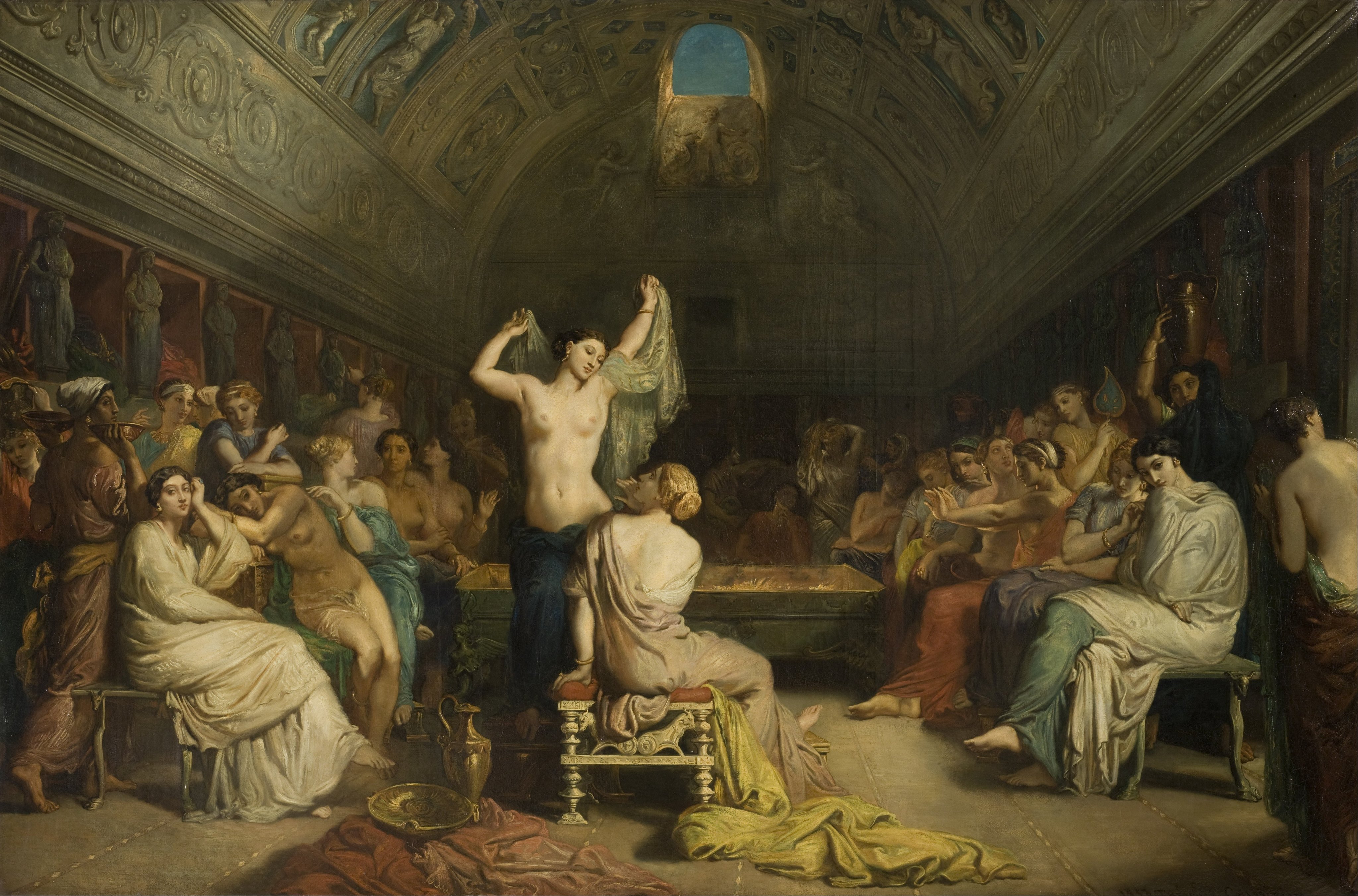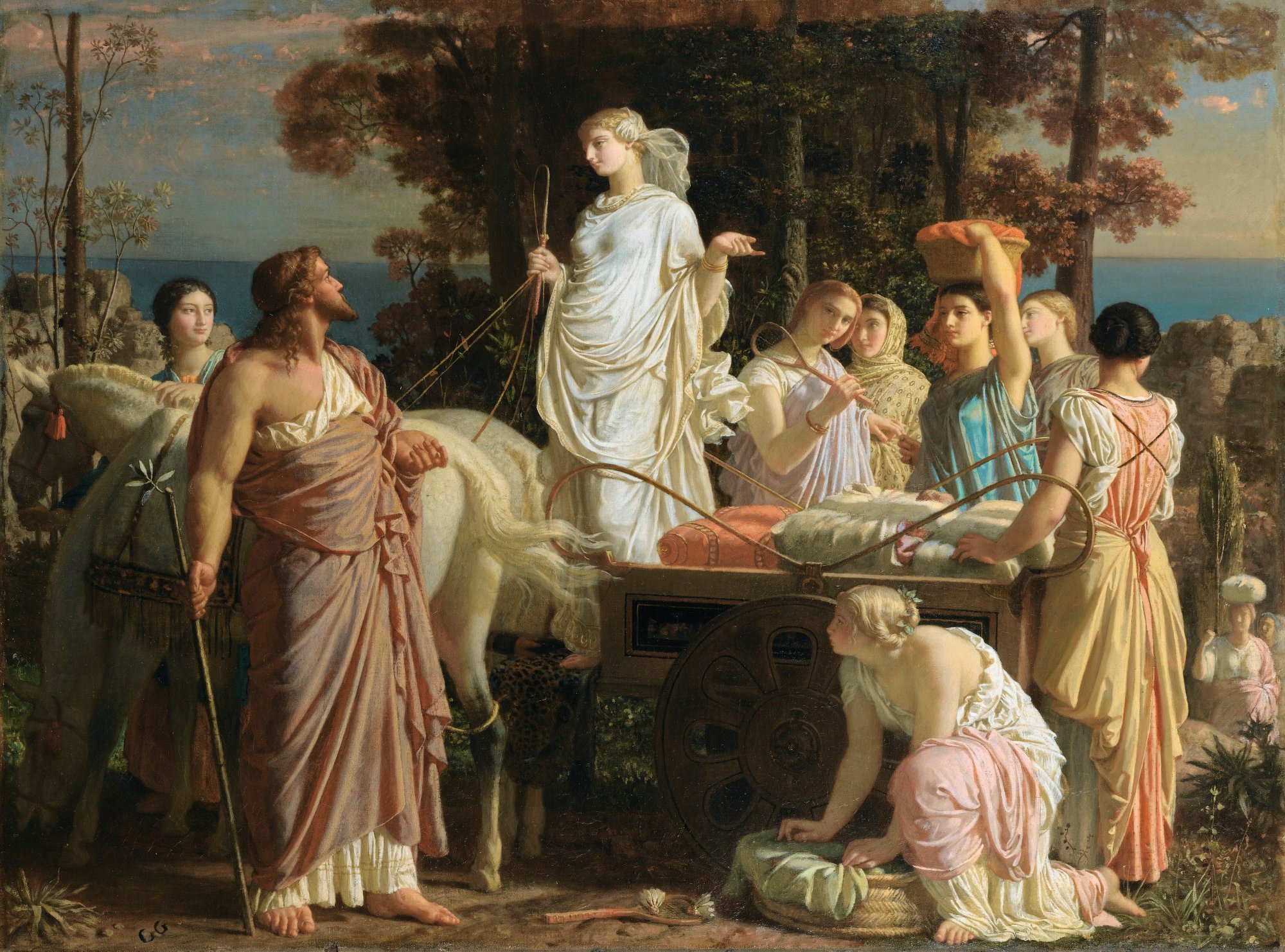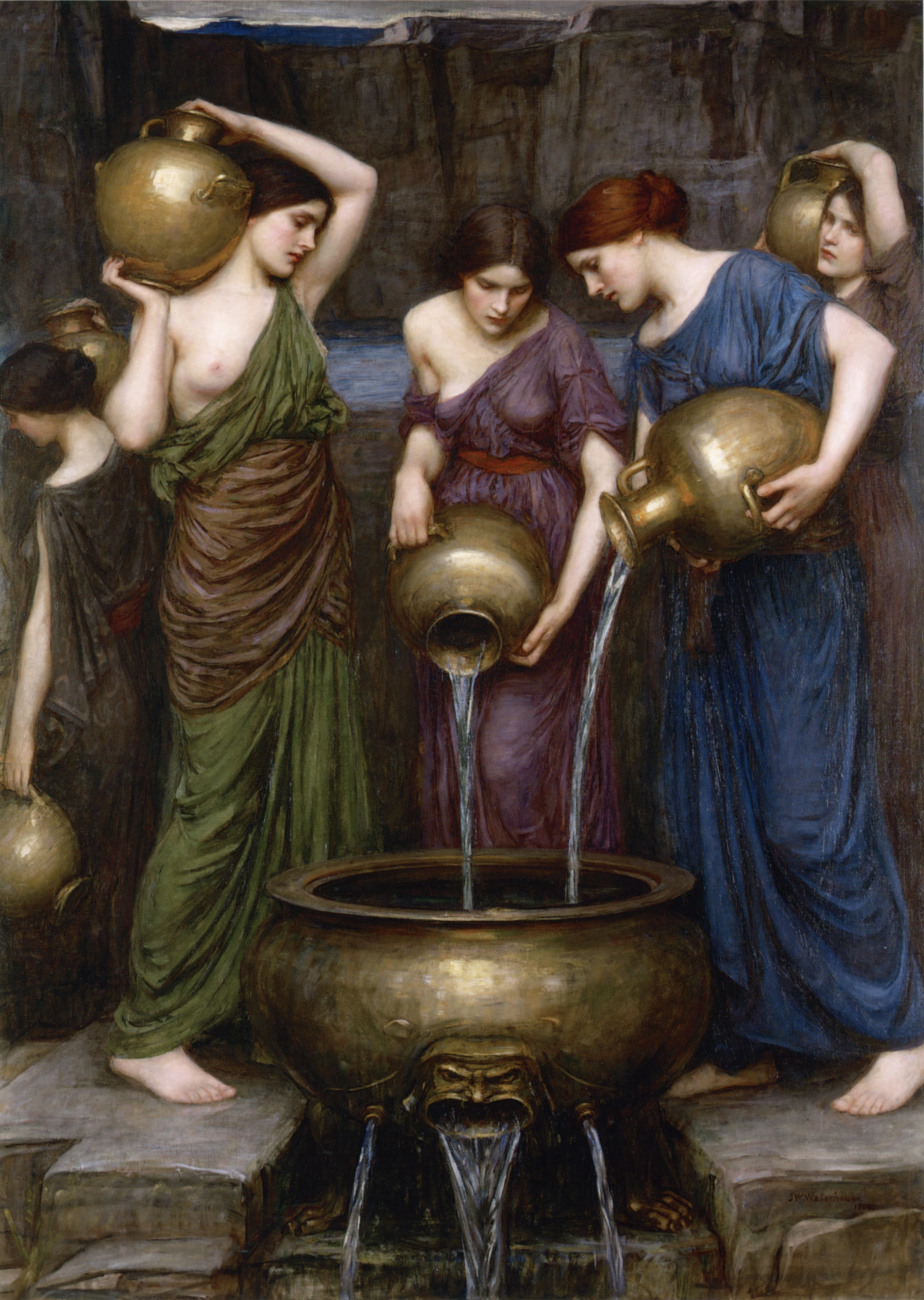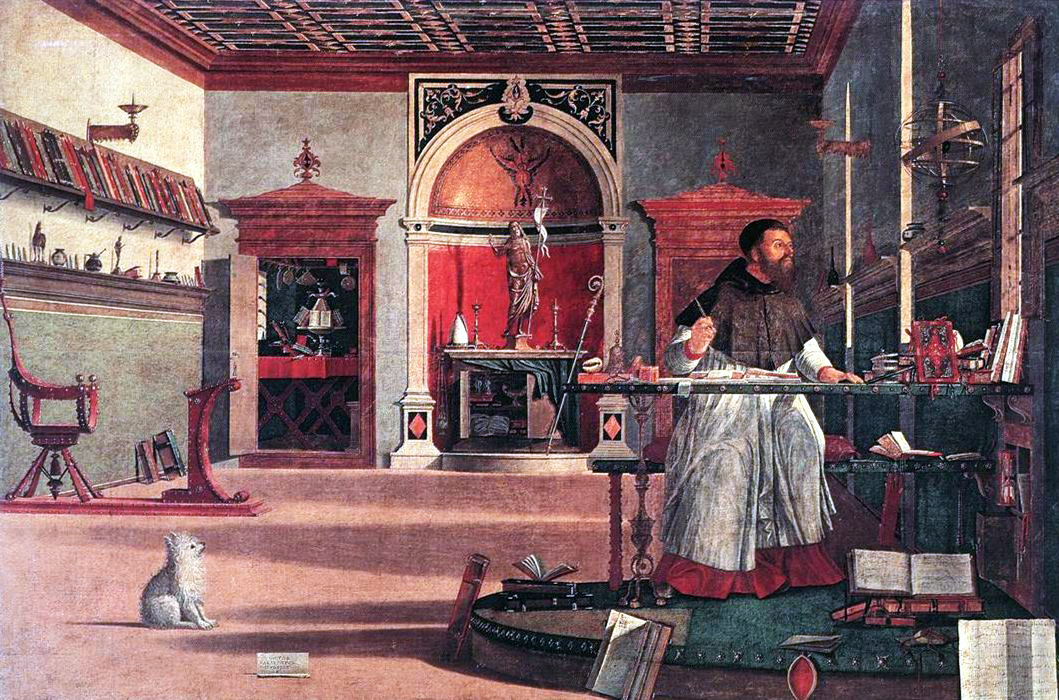Théodore Chassériau, 1853 (Musée d’Orsay, Paris)
Category: Painting
Ulysses and Nausicaa
The Danaides
The Women of Amphissa
Nymphes et un satyre
Painting of the day
Christ and the rich young ruler

Saint John the Evangelist, a painting by the Italian Baroque painter Domenichino. The problem with the splendid Christian art is that the painters have Nordicized the Semites of the 1st century. Had photography existed in the 1st century of our era, the Aryans would never have projected their beautiful physiques on the ugly rabble of Palestine.
______ 卐 ______
Neither the Gospel of Matthew, nor the Gospel of John, nor John’s Book of Revelation come from the apostles to whom the Church attributes them
Due to the great importance of the ‘apostolic tradition’, the Catholic Church published all the Gospels as books of the apostles or their disciples, which justified their prestige. But there is no proof that Mark and Luke, whose names appear in the New Testament, are disciples of the apostles; that Mark is identical to the companion of Peter, or that Luke was Paul’s companion. The four Gospels were transmitted anonymously.
The first ecclesiastical testimony in favour of ‘Mark’, the oldest of the evangelists, comes from Bishop Papias of Hierapolis, in the middle of the 2nd century. But today there are many researchers who criticise the testimony of Papias; call him ‘historically worthless’ (Marxsen), and even admit that Mark ‘has never heard and accompanied the Lord’.
The apostle Matthew, a disciple of Jesus, is not the author of the Gospel of Saint Matthew which appeared between the 70s and 90s, as is generally assumed. We ignore how he got the reputation of being an evangelist. It is evident that the first testimony comes from the historian of the Church, Eusebius, who in turn accepted the claim of Bishop Papias: about whom he writes that ‘intellectually, he should have been quite limited’. The title ‘Gospel of Matthew’ comes from a later period: we find it for the first time with Clement of Alexandria and Tertullian. Both died at the beginning of the 3rd century. If the apostle Matthew, contemporary of Jesus and witness of his works, had written the Gospel that is attributed to him, would he have had to borrow so heavily from Mark? Was he so forgetful? Did he have so little inspiration?
All critical biblical research considers that there is no reason why the name of the apostle Matthew should appear on the Gospel, since it was not written in Hebrew, as the tradition of the ancient Church affirms, but in Greek. No one is known to have seen the Aramaic original, nor is anyone known to have translated it into Greek; nor in the manuscripts or citations is the slightest remnant of an original Aramaic text preserved. Wolfgang Speyer rightly includes the Gospel of Matthew among ‘fakes under the mask of religious revelations’. K. Stendhal ventures that it is not even the work of a single person but of a ‘school’. According to an almost unanimous opinion of all the non-Catholic researchers of the Bible, that gospel is not based on eyewitnesses.
The most recent Catholic theologians often painfully turn on these facts. ‘In case our Greek version of the Gospel of Matthew had been preceded by an original version in Aramaic…’ writes K. H. Sohelkle. Of course, ‘in case’, says Hebbel with irony, is the most Germanic of the expressions’.
‘An original Aramaic Matthew must have been written several decades before the Greek Matthew’. Not even they themselves believe this. Lichtenberg was not the first to know but was the first to say it accurately: ‘It is clear that the Christian religion is supported more by those people who earn their bread with it than by those who are convinced of its truth’.
It is interesting that the first three Gospels were not published as apostolic, the same as the Acts of the Apostles, whose author we also ignore. The only thing we know is that he who wrote these Acts of the Apostles simply puts on the lips of his ‘heroes’ the most appropriate phrases: something common in old historiography. But these inventions not only constitute a third part of the Acts of the Apostles but are also their most important theological content and, what is particularly remarkable, the writing of this author represents more than a quarter of the entire New Testament. It is generally supposed that the author of the Gospel of Luke is identical to the travelling companion and ‘beloved physician’ of the apostle Paul. But neither the Gospel of Luke nor the Acts of the Apostles are very Pauline. Researchers do not believe today that either of these two works was written by a disciple of Paul.
The Acts of the Apostles and the three Gospels were not signed with the true name or even with pseudonyms: they were anonymous works like many other proto-Christian works, such as the Epistle to the Hebrews of the New Testament. No author of the canonical Gospels cites his name, not once does he mention a guarantor, as the later Christian treatises so often do. It was the Church the first to attribute all these anonymous writings to certain apostles and their disciples. However, such attributions are ‘hoaxes’, they are a ‘literary deception’ (Heinrici). Arnold Meyer notes that ‘with certainty only the letters of the apostle Paul are authentic, who was not an immediate disciple of Jesus’. But it is well known that not all those epistles that appear under his name come from Paul.
John
Since the end of the 2nd century, from Irenaeus, although at first not without controversy, the Church attributes without reason the fourth Gospel to the apostle John: something that all critical researchers have questioned for more than two hundred years. There are many weighty reasons for raising questions.
Although the author of this fourth Gospel, who curiously does not mention any author, affirms having leaned on the chest of Jesus and being a reliable witness, he assures and repeats emphatically that his ‘testimony is true’, that ‘he has seen’ and that he ‘knows’ he is telling the truth so that we ‘may believe’. But this Gospel did not appear until about the year 100, while the Apostle John had been killed long ago, towards the year 44 or, probably, in 62.
The Father of the Church, Irenaeus, who was the first to affirm the authorship of the apostle John, has intentionally confused him with a priest, John of Ephesus. And the author of the second and third epistles of John, which are also attributed to the apostle John, calls himself at the beginning, ‘the presbyter’ (a similar confusion also occurred between the apostle Philip and the ‘deacon’ Philip). Even Pope Damasus I, in his canonical index (382), does not attribute two of John’s epistles to the apostle John, but to ‘another John, the presbyter’. Also, even the Father of the Church Jerome denied that these second and third epistles belonged to the apostle. The arguments against the authorship of the apostle John as ‘the Evangelist’ are so numerous and convincing that even Catholic theologians are starting to manifest, little by little, their doubts.
The same could be said about the Book of Revelation of John, whose author is repeatedly called John both at the beginning and at the end of the book, who also appears as a servant of God and brother of Christians, but not as an apostle. The book was written, according to the doctrine of the ancient Church, by the son of Zebedee, the apostle John, since an ‘apostolic’ tradition was needed to guarantee the canonical prestige of the book. But it did not last long given that the Book of Revelation, which appeared in the last place of the New Testament, was rejected by the end of the 2nd century by the critics of the Bible who otherwise did not deny any dogma.
Pope Dionysius of Alexandria (died 264-265), a disciple of Origen and nicknamed ‘the Great’, categorically denied that John was the author of the Apocalypse. Pope Dionysius points out that primitive Christians have already ‘denied and completely rejected’ the ‘Revelation of John’.
They challenged each and every one of the chapters and declared that the work lacked meaning and uniqueness and that the title was false. They affirmed, in particular, that it did not come from John and that they were not revelations since they were surrounded by a multitude of incomprehensible things. The author of this work was not one of the apostles, no saint and no member of the Church, but Cerinthus, who wanted to give a credible name for his forgery and also for the sect of his own name.
The theologian and Protestant bishop Eduard Lohse comments: ‘Dionysius of Alexandria has very accurately observed that the Revelation of John and the Fourth Gospel are so far apart in form and content that they cannot be attributed to the same author’. The question remains whether the author of the Book of Revelation wanted to suggest, by his name John, to be considered a disciple and apostle of Jesus. He does not say that explicitly: it was done by the Church to confer apostolic authority and canonical prestige on his text. And so falsifications started: the falsifications of the Church.
______ 卐 ______
Liked it? Take a second to support this site.
Sant’Agostino nello studio by Vittore Carpaccio (1502)
‘Genius in all fields of Christian doctrine’
[Augustine] often dictated at the same time discussions to several writings: 93 works or 232 ‘books’, he says in the year 427 in his Retractationes (which critically contemplate, so to speak, his work in chronological succession), to which we must add the production of his last years of life, in addition to hundreds of letters and sermons, with which he ‘almost always’ felt dissatisfied.
The intellectual production of Augustine was overrated, particularly from the Catholic side. ‘An intellectual giant like him, only the world offers it once every thousand years’ (Görlich). Maybe from the Catholic world! However, what he calls ‘intellectual stature’ is what serves him, and what serves him is detrimental to the world.
Augustine’s existence precisely reveals it drastically. However, J.R. Palangue praises him as ‘a genius in all fields of Christian doctrine’. And Daniel-Rops goes on to say: ‘If the word genius has any meaning, it is precisely here. Of all the gifts of the spirit that can be fixed analytically, none was missing; he had all, even those that are generally considered mutually exclusive’. Who is startled by such nonsense is called malevolent, malicious, ‘a creeping soul’ (Marrou). However, even the father of the Church Jerome, although out of envy, called his colleague ‘a little latecomer’. In the 20th century, the Catholic Schmaus flatly denies Augustine’s genius as a thinker.
The thought of Augustine? It is totally dominated by ideas of God, partly numbed by euphoria, partly terrified. His philosophy is, basically, theology. From an ontological point of view, it is based on hypotheses without any foundation. And there is a multitude of painful absences.
Augustine, whom Palangue praises saying: ‘With a flap he rises above any superficial objection’ usually is a prodigy of superficiality. Also the ‘professional orator’ of yesteryear (and today!) cheats through rhetorical tricks. He contradicts himself, especially in The City of God, a work with a strong influence of Arnobius that appeared between 413 and 426, his ‘magnum opus’ as he says, where he sometimes equates and others clearly differentiates his own fundamental concepts: ‘Roman Empire’ and ‘Diabolic State’. Or ‘Church’ and ‘God’s State’.
When he was a young Christian, he believed that miracles no longer occur, so that ‘no one is raised from the dead anymore’; when he gets old he believes otherwise. Already in 412 he had the idea of ‘collecting and showing everything that is rightly censured in my books’. And so, three years before his death he begins, since everything was ‘altered’, a complete book with rectifications, Retractationes, without really ‘rectifying’ everything. In any case, he introduced 220 corrections.
However, as many times as Augustine ‘rectified’ something, he refuted others’ work, placing the heading of many of his writings a ‘Contra […]’.
At the end of the 4th century he attacked the Manichaeans: Fortunatus, Adeimantus, Faust, Felix, Secundinus, as well as, in another series of books, Manichaeism: of which he himself was formally a follower for almost a decade, from 373 to 382, although as ‘listener’ (auditor), not as an electus. In three books Against Academics (386) he confronts scepticism. From the year 400 on he criticises Donatism; from 412 Pelagianism, and from 426 semi-Pelagianism. But next to these main objectives of his struggle, he also attacks with greater or lesser intensity the pagans, the Jews, the Arians, the astrologers, the Priscillians and the Apollinarians. ‘All the heretics hate you’ he praises his old rival Jerome, ‘just as they persecute me with the same hatred’.
More than half of Augustine’s writings are apologetics or have a controversial character. On the other hand, while, being a bishop, in thirty years he only once visited Mauritania, the less civilized province, he travelled thirty-three times to the incredibly rich Carthage, where, apparently as compensation for his modest convent diet, he liked copious lunches (for example roasted peacock); talk to important people and spend whole months with colleagues in hectic activity. The bishops already lived near the authorities and in the court, and were themselves courtiers; Augustine’s friend, Bishop Alypius, was arguing in Rome until the saint’s death.
Peter Brown, one of the most recent biographers of the leading theologian, writes: ‘Augustine was the son of a violent father and an inflexible mother. He could cling to what he considered objective truth with the remarkable ingenuity of his quarrelsome character’.
It should be noted that the increasingly violent aggression of Augustine, as manifested in his dispute with the Donatists, could also be a consequence of his prolonged asceticism. Before, as he himself confessed, he had had remarkable vital needs, ‘in lewdness and in prostitution’ he had ‘spent his strength’, and later he had energetically conjured ‘the tingling of desire’. He lived a long time in concubinage, later he took a girl as a girlfriend (she had almost two years to reach the legal age to get married: in girls twelve years) and at the same time a new darling. But for the cleric sexual pleasure is ‘monstrous’, ‘diabolical’, ‘disease’, ‘madness’, ‘rottenness’, ‘nauseating pus’, and so on.
Apart from that, was not he also feeling guilty about his long-time companion, whom he had forced to separate from himself and his son?
______ 卐 ______
Liked it? Take a second to support The West’s Darkest Hour.
The Republic
The last words of Will Durant in the previous entry of this series: ‘Let us study The Republic’. But in this post I will not quote any passage from Durant’s book. I will give my opinion on this classic work that bequeathed us historical Greece.
In the first place, it must be recognised that the race of the ancient Greeks was of the Nordic type. In The Fair Race there are two articles on the subject, one written by a Spaniard and another by an American. Since then civilisation has metamorphosed so much, especially in axiology, technology and demography, that what Plato wrote could only be valid after the extermination of all non-whites, as William Pierce put it at the end of The Turner Diaries. Sorry, but the Greeks of the ancient world were physically beautiful, says the article of the mentioned Spaniard. Hence, in our technological times with a demographic explosion that, because of Christianity, reversed the beautiful values of the classical world, only in an ethnically cleansed Earth what the ancient Greek philosophers discussed could become germane again.
The tragedy of the Aryans reminds me of the meaning of the One Ring in the tetralogy of Wagner, a symbol that Tolkien would pick up in his novel. It has been Aryan greed what blinded them to the fact that using non-whites as capital was suicide in the long term. That is the moral that emerges from the stories about the white race of William Pierce and Arthur Kemp. But even from the 19th century some Americans felt the danger, as shown in the paintings of Thomas Cole. A world with the destroyed Ring means, in many aspects, a return to the small cities: the subject matter not only for Plato but for Aristotle. For the latter, a Greek city should not exceed ten thousand inhabitants…
That is precisely the moral of my books in Spanish: after so many hells in ‘the Black Iron Age’ as I said as a teenager, I propose a return to the Shire so to speak. For the same reason, if there is something that hurts me when I see the sites of white nationalists, it is that they are cut off from their European past. I have spoken on this site about music, but not much about painting. The following is the oil canvas by Claude Le Lorrain (1600-1682) that appears at the top of my Facebook page:

On my most recent trip to London I saw some splendid canvases of Le Lorrain’s paintings in the National Gallery. Outside of London and the madding crowd, some English aristocrats of past centuries took Le Lorrain as a paradigm to mould their extensive lands, and even some buildings in the countryside. Some of this can even be seen in the movies of this century. In this very beautiful film of 2005 for example, when Mr Darcy declares his love to Elizabeth, I could not contain my admiration for that place: it seems to be taken from a canvas by my favourite painter (watch the last ten seconds of this YouTube clip)! Who of the contemporary racists has such contact with their visual past?
A true racist should reject any image of pop culture sold to us by American Jewry. But going back to Plato. Let us suppose, just suppose, that the white race will emerge alive from the coming apocalypse and that, in an Earth already without Orcs and (((Sauron))), they would reconstruct white civilization. In an unpopulated land and with only a few small cities, like the one seen in the painting above, the question would arise as to what kind of government is desirable. In this world, the survivor could be asked about Plato’s magnum opus, something like a second chance or a fresh start for the West. So let’s expose our views about the philosopher.
The first thing I could say is that the distortion that is taught in the academy about the classical world is such that we would have to change the title of The Republic for the simple fact that it is an invented title. The original in Greek was Politeia, whose translation would be ‘regime or government of the polis’, that is to say how to govern a small city-state. The title The Republic falsifies the mind of Plato already from the cover of the book we see in bookstores, inducing the popular notion that the author was an utopian. He was nothing of the sort. Politeia was the recipe of Plato to remedy the bad governments he saw in ancient Greece. His starting point had been the examination of the Greek cities of his time, not of a hazy future but the four regimes of Greece: timocracy, oligarchy, democracy and tyranny.
Imagine a world à la Lorrain in which only whites inherit the Earth. The bookstores, this time with imprimaturs that do not admit anything from Semitic pens, would show Plato’s main work with the original title… But that does not mean that we should consider the disciple of Socrates a provider of laws, a new Lycurgus. At this stage of the historical game it is obvious that Plato did not see, nor could he see, the iniquity of the world; of men, of the Jewry that would invent Christianity, and the catastrophic industrial revolution.
For example, Plato does not speak of the need to keep Nordic blood pure, at least not with the lucidity the Nazis had. The closed polis of the Spartans complied more with the laws of nature than the open polis of the Athenians (in this Durant was fatally wrong). But not even the Spartans knew Pierce’s formula: to maintain an Aryan culture one must maintain the Aryan ethnicity: and that can only be done by exterminating or expelling all non-Aryans.
Plato’s missteps go further. Above I complained that the typical racist of today has no internal contact with the world of the great masters of painting. Another common ailment in those who have abandoned Christianity is that they keep infectious waste that puts the Aryans at a clear disadvantage compared to the Jewish quarter. One of these residues is the belief in post-mortem life. He who believes this doctrine will not fight as much in this life as the Jews are currently fighting, insofar as they believe they will have a second chance (either in the afterlife or reincarnated).
Jews do not masturbate their minds with unearthly hopes: one of their enormous advantages before us. But to be fair to Christianity I must say that even before Christianity Plato already masturbated his mind, and the minds of his male pupils, with such fantasies: what I have called in this series the root of the baobab. In fact, Plato finishes his great work sermonizing us: if we stick to what he says and believe in the immortal soul, we will be happy:
Thus, Glaucon, the tale has been saved, and will be our salvation, if we believe that the soul is immortal, and hold fast to the heavenly way of Justice and Knowledge. So shall we pass undefiled over the river of Forgetfulness, and be dear to ourselves and to the Gods, and have a crown of reward and happiness both in this world and also in the millennial pilgrimage of the other.
As I observed in a previous entry, during the savage destruction of most of the books of the classical world by the Judeo-Christians, it survived a work that many consider a precursor of the Christian doctrine of the human soul. The Republic, to use the falsified title, is anachronistic in many other ways. In addition to his post-mortem masturbations, what is the point of praising Plato when he did not oppose the incipient miscegenation of Athens with the greatest possible vehemence?
Unlike every rabbi who practices intuitive eugenics, Plato did not even leave offspring. He was not a husband or father. In his case, no good genes passed to the next generation (where his sperm ended, I dare not speculate). Moreover, he believed that in his republic women could perform the same functions of the male, even the highest. Compare the feminism of this philosopher of 2,400 years ago with what the Orthodox Jews of New York teach today: they educate their women to behave like little red riding hoods!
Whoever complies with the laws of Nature survives and who violates them perishes. At present the Jews fulfil them and the Aryans violate them. The white race will not be saved unless it makes a destructive criticism of much of what passes for ‘wisdom of the West’, starting with the Greeks.







